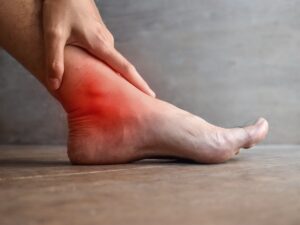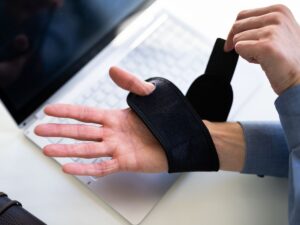Why Ankle and Foot Health Matters
Our feet and ankles form the foundational support for nearly every movement we make, from walking and running to balancing and standing still. When pain or discomfort arises in these areas, simple daily tasks can become daunting, and exercise routines may come to a halt. While the causes of ankle and foot pain can vary—ranging from overuse injuries and arthritis to acute traumas or improperly fitting footwear—the impact on overall mobility is often the same. Understanding the underlying factors and learning how to treat them properly can significantly reduce discomfort, speed recovery, and help you regain your active lifestyle. That’s where a structured relief therapy plan proves invaluable.
Common Causes of Ankle and Foot Pain
Many factors contribute to foot and ankle pain, but a handful frequently occur among patients seeking relief:
- Plantar Fasciitis: Inflammation of the plantar fascia—a thick band of tissue along the bottom of the foot—causes heel pain, especially upon waking or after prolonged sitting.
- Achilles Tendonitis: Overuse or strain of the Achilles tendon can lead to tightness, swelling, and limited range of motion in the back of the heel.
- Sprains and Strains: Twisting or rolling the ankle awkwardly stretches or tears ligaments and muscles, leading to swelling, bruising, and pain.
- Arthritis: Degenerative changes or inflammation in the joints of the foot and ankle can result in chronic pain and stiffness, particularly in older adults.
- Stress Fractures: Repetitive impact or sudden increases in activity can produce hairline fractures in the foot bones, leading to localized tenderness and swelling.
Identifying the specific cause of your ankle or foot pain is the first step toward effective treatment. A thorough exam—often involving imaging or a physical assessment—pinpoints the injured structures, enabling a more targeted and efficient therapy plan.
Signs You Shouldn’t Ignore
Sporadic aches in the feet or ankles may not always indicate a serious problem, but there are key indicators that point to the need for professional evaluation:
- Persistent Swelling: Ongoing swelling that doesn’t subside with rest, ice, or elevation may point to ligament tears or underlying inflammation.
- Joint Instability: Feeling like your ankle might “give out” can signal ligament damage or muscle weakness that needs corrective therapy.
- Sharp, Shooting Pain: Sudden stabbing sensations sometimes indicate nerve irritation or stress fractures.
- Reduced Range of Motion: Difficulty pointing or flexing your toes, or turning your ankle, can reveal tendon dysfunction or joint issues.
- Visible Deformities: Misalignment or bulging in the foot structure calls for immediate evaluation to avoid long-term complications.
Rather than waiting for the condition to worsen, seeking help early often leads to quicker recovery and a lower chance of chronic instability or persistent pain.
Conservative Treatments and Self-Care
Most ankle and foot pain cases, especially those without severe ligament tears or fractures, respond well to conservative therapies. Basic self-care measures can provide initial relief:
- RICE Protocol: Rest, Ice, Compression, and Elevation remain the cornerstone for acute injuries to manage swelling and inflammation.
- Nonsteroidal Anti-Inflammatory Drugs (NSAIDs): Over-the-counter medications such as ibuprofen may reduce pain and swelling when used short-term.
- Footwear Modifications: Switching to shoes with proper arch support and shock-absorbing soles can alleviate pressure on irritated tissues.
- Orthotics or Inserts: Custom or store-bought inserts can correct biomechanical imbalances, preventing undue strain on tendons and ligaments.
In many instances, these measures form a foundation upon which further rehabilitation is built. When combined with structured therapeutic exercises and manual interventions, the recovery process often accelerates. The key is consistency—regular adherence to these conservative measures can mitigate pain flare-ups and keep you active throughout healing.
The Role of Professional Therapy
While at-home treatments are helpful, more persistent or complex ankle and foot pain may require professional intervention. A qualified physical therapist will evaluate gait, muscle strength, flexibility, and joint function to develop a tailored plan. By targeting the root cause of discomfort—whether it’s an unstable ankle joint, tight calf muscles, or overpronation—a focused therapy program can restore function and minimize the risk of re-injury. In some cases, a chiropractor or sports medicine specialist can collaborate with physical therapists to optimize alignment and mobility, particularly if there’s a biomechanical component affecting the lower limbs.
Targeted Exercises and Stretches
Structured exercise is integral for rehabilitating and fortifying the feet and ankles. Specific drills address muscle imbalances, joint stiffness, and poor coordination:
- Calf Stretches: Placing hands on a wall, step one foot behind you and press the heel down, elongating the calf and Achilles tendon.
- Heel Raises: Stand on a step or flat surface and rise onto the balls of your feet, then slowly lower. This strengthens the calf muscles and tendons around the ankle.
- Toe Curls and Extensions: Using a towel on the floor, curl your toes to grip the towel and then extend them fully for improved foot flexibility.
- Ankle Circles: While seated or lying down, rotate your ankles clockwise and counterclockwise, enhancing joint range of motion.
- Balance Drills: Standing on one foot for 30-second intervals or using a balance board can bolster ankle stability and proprioception.
Repetitions, resistance, and difficulty levels are usually adjusted as the ankle or foot gains strength and stability. Consistency is crucial: performing these exercises regularly—ideally under the guidance of a professional—lays a solid foundation for enduring pain relief and a return to normal activities.
Manual Therapy and Advanced Modalities
Beyond exercise, healthcare providers may apply additional therapies to expedite recovery:
- Soft Tissue Mobilization: A therapist uses hands-on techniques to break up adhesions, release muscle tension, and enhance circulation.
- Joint Mobilization or Manipulation: Adjusting the ankle or foot joints can improve alignment, possibly easing pain from misalignment or impingement.
- Ultrasound or Electrical Stimulation: Noninvasive machines help reduce inflammation, promote tissue repair, and temporarily relieve pain.
- Laser Therapy: Low-level lasers may decrease inflammation and speed cell regeneration, though evidence and availability vary.
Professionals often combine multiple methods into a single treatment session, creating a layered approach that tackles pain from multiple angles. The goal is not merely symptom relief, but restoring functional capacity so patients can walk, run, or stand with less strain.
How Dr. Elham Approaches Ankle and Foot Pain
Dr. Elham emphasizes a patient-centric, integrative strategy for healing ankle and foot injuries. In addition to meticulous assessments that measure range of motion, gait patterns, and muscle imbalances, she views each case within the broader context of a patient’s lifestyle. This holistic perspective may involve discussions about footwear, daily habits that stress the feet, or nutritional factors influencing tissue healing. Dr. Elham tailors individualized therapies—ranging from targeted manual interventions to guided strength exercises—that aim to correct underlying dysfunction while easing present discomfort. For many patients, her approach includes practical education on proactive steps, such as foot care routines or posture adjustments. If a more advanced intervention is necessary, Dr. Elham coordinates with other specialists, ensuring comprehensive care from start to finish.
Importance of Footwear and Orthotics
Something as simple as wearing the right type of shoe can substantially influence recovery from foot and ankle issues. High heels, flimsy flip-flops, or worn-out sneakers often exacerbate existing problems. Shoes that offer arch support and a wide toe box can relieve pressure on sensitive areas like the ball of the foot or Achilles tendon. In more complex cases—like severe overpronation or high arches—custom orthotics prescribed by a specialist offer precision support, helping align the ankle and foot properly. Orthotics aren’t just for athletes; they’re beneficial for anyone dealing with chronic pain, tendonitis, or arthritic changes in the feet. Regularly replacing worn shoes or insoles is also vital, as the cushioning and support degrade over time, diminishing their protective benefits.
Sports and Activity Considerations
Athletes and fitness enthusiasts sometimes push through pain, risking further injury. If you’re dealing with ankle or foot discomfort, consider adjusting training intensity or volume. Activities with heavy impact—like running or high-intensity interval workouts—could aggravate inflamed tissues. Low-impact options, such as swimming, cycling, or using an elliptical machine, let you maintain cardiovascular fitness without placing undue stress on healing structures. Using protective gear—like ankle braces or compression sleeves—offers extra stability during recovery. A gradual return-to-sport protocol, overseen by a therapist or coach, ensures you ramp up safely, preventing relapses or compensatory injuries in other joints.
Nutritional and Lifestyle Factors
Although it may not be the first consideration, nutrition and overall lifestyle can heavily impact healing. Consuming a balanced diet rich in protein, vitamins, and minerals helps repair damaged tissues. Anti-inflammatory foods—such as fatty fish, leafy greens, and berries—may ease swelling and discomfort. Staying hydrated supports joint lubrication and muscle function, reducing cramping or stiffness. Moreover, stress and inadequate sleep can prolong recovery, as they impede optimal tissue repair and contribute to muscle tension. Making a concerted effort to manage stress—through techniques like yoga, meditation, or simple deep breathing—can complement formal therapies for ankle and foot pain.
Invasive Interventions: When Are They Necessary?
In most cases, conservative measures effectively address ankle and foot pain. However, situations like severe ligament tears, advanced arthritis, or chronic tendon ruptures may necessitate surgery. Common procedures range from arthroscopic clean-ups of scar tissue to total joint replacement in dire circumstances. Post-surgery rehabilitation is often lengthy, requiring phased weight-bearing and careful progression of exercises. Committing to a thorough rehab plan greatly enhances surgical outcomes, helping patients eventually return to sports or daily tasks with improved joint stability. If you’re weighing surgical options, be sure to discuss the likely recovery timeline and potential complications with your medical team so you can make an informed choice.
When to Seek Professional Help
Ankle or foot pain lasting longer than a week—or getting worse despite rest—signals the need for professional assessment. Early intervention prevents minor issues from morphing into chronic conditions, which can be tougher to reverse. If you notice consistent swelling, bruising, or structural changes like bunions or hammertoes, schedule an evaluation. In some cases, nerve compression or vascular issues may mimic musculoskeletal pain, underscoring the value of a complete exam. By partnering with specialists or a rehabilitation-focused provider like Dr. Elham, you gain clarity about the best path forward, whether that’s exercise-based therapy, orthotic support, or referral for advanced imaging and treatment.
Maintaining Progress and Preventing Relapses
Long-term success in overcoming ankle and foot pain hinges on consistency and preventive care. Even after noticeable improvements, continuing a scaled-down version of your exercise regimen helps keep muscles strong and flexible, minimizing the likelihood of re-injury. Regularly checking your gait—by using mirrors, gait analysis apps, or periodic professional follow-ups—can catch minor shifts in movement before they escalate into discomfort. Subtle lifestyle tweaks—like using stairs correctly, walking mindfully on uneven surfaces, or maintaining healthy body weight—further safeguard your feet and ankles. Because these joints bear cumulative stress day after day, a proactive approach ensures that everyday life doesn’t reintroduce the very pain you worked hard to eliminate.
Taking the First Step Toward Relief
Ankle and foot pain can be deeply disruptive, altering how you move, exercise, and enjoy life. The positive news is that most cases respond well to a carefully orchestrated mix of rest, targeted exercises, manual therapies, footwear adjustments, and, when necessary, advanced treatment. It’s all about identifying the root cause and tailoring solutions to your unique condition and lifestyle. If you’re ready to explore professional guidance, consider tapping into our dedicated resource on Ankle and Foot Pain Relief Therapy. By developing a well-rounded plan—potentially in collaboration with Dr. Elham—you stand a solid chance of regaining comfort and reclaiming your mobility, one step at a time.

















